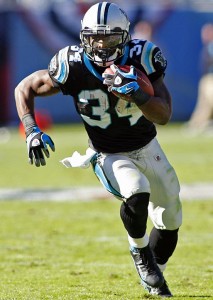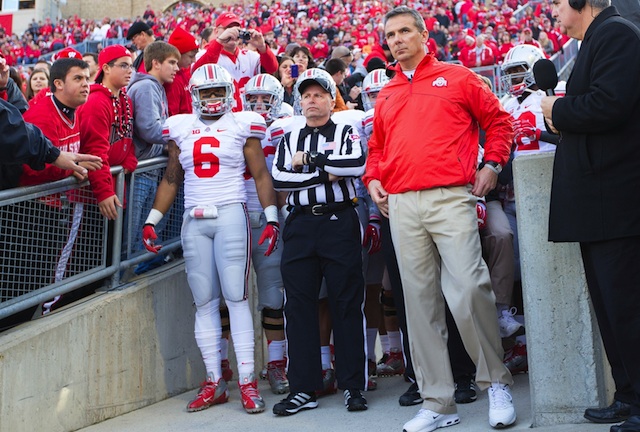All the hype surrounding Cam Newton and this Panthers offense involves using spread formations, the zone read, and many other “futuristic” offensive concepts to take advantage of Newton’s unique running ability at the quarterback position.
While it’s true that Carolina does a lot of things out of the shotgun and uses option schemes (at times), they also spend plenty of time under center and in traditional two-back sets running old school power football.
Newton gets a lot of praise for the turnaround in Carolina, as he should, but it’s also worth noting that he benefits from having all three of the things that are great for a young and developing quarterback:
- A strong running game
- A reliable veteran receiver
- A tough defense
This post is going to deal with the first two on that list. First, let’s see how Panthers offensive coordinator Mike Shula mixes old school football with some new school concepts to find creative ways to move the football.
The Run Game
The Panthers run game consists of several traditional concepts that have been adapted to fit their personnel. Let’s take a look at some examples.
The Power Play
In this play, Carolina takes a classic run scheme, the power play, and runs what is usually a two-back play out of a single back shotgun set.
Carolina is facing six defenders in the box, meaning that they’ve got a man for a man when it comes to blocking. Newton will hand the ball off to Johnathan Stewart, and you’ll see the three linemen to the right “block down”, or block in the opposite direction of the point of attack and take the first man in their gap.
Meanwhile, the TE will block out on the man lined up on his outside shoulder, and there will be a huge hole open up for the running back, as you’ll be able to see clearer from the end zone view.
The left guard pulls around through the hole created on the right side of the line, taking the first opponent jersey he sees. The left tackle will take what’s called a “hinge” step to seal off some of the hole created by the pulling guard, while making himself perpendicular to the line of scrimmage to create a longer edge for the backside defensive end to get around.
This play is a staple of every team’s running attack in the NFL, and it’s rare to find a team at the college and high school level that doesn’t use it in some way. Next, let’s look at an option play that uses some principles from the power play and lets Newton use his legs.
The Sweep Read
The next play is a mix of the power run scheme we just looked at and an option play as well. The Panthers line up in a 3×1 trips set with the TE Greg Olsen aligned off the line of scrimmage. Newton sends him in return motion from right to left back to the right again.
On the snap, instead of blocking down on the defensive end, the TE will block out on the first defender that shows as a threat outside of him, whether it’s an outside linebacker or a safety.
In this case, the defender who lined up on the slot receiver comes on a blitz, so the tight end will wall him off from the play.
Just like the last play, the right tackle, right guard, and center all block down, and the left tackle will make a hinge block on the backside of the play. The left guard pulls around, staying tight off the backside of the right tackle, careful not to go too wide.
This is because he wants to give the defensive end as much space as possible to cover.
Newton will take the snap, and immediately his eyes go to his read key, the defensive end to his right. He puts the ball out and will ride the “mesh point” with the running back (The point in the backfield where the exchange between the QB and RB takes place), deciding whether or not to give it depending on the actions of the defensive end being read. If he sees the DE close down the line and come after him, he’ll give it around the edge to DeAngelo Williams on the sweep.
On the other hand, if the DE chases the sweep, Newton will keep it and run straight up the middle for whatever he can.
That’s exactly what happens on this play, and Cam Newton runs up the middle for a big gain against the Giants defense. Next, we’ll take a look at the much-talked-about zone read everyone’s been so excited about this season.
Zone Read Option
This play is run out of a “full house” or “diamond” set, meaning that there are three running backs in the backfield along with the quarterback. This formation has come back into vogue recently because of all the misdirection possibilities with so many players in the backfield.
Once again, Newton will read a defensive end, but on this play he has to quickly adjust, since the defensive line has slanted to the left, meaning not one but two unblocked defensive linemen. He knows from the pre-snap alignment of the defense that there are no second level defenders to the left side of the defense, so that if he pitches it to DeAngelo Williams on the edge, there won’t be anyone there to stop him.
He quickly has the defensive end in his face, so he pitches it to Williams, the third option on the play. Williams picks up a nice gain and the Panthers get inside the ten yard line.
Now, this is not the only way that the Panthers can run the option, but for the sake of brevity we’ll have to keep it at that.
Steve Smith and the rest of the Carolina Passing Attack
A young, mobile QB is usually doing a lot of running around, and not just on designed quarterback runs. Good chemistry between a young QB and his receivers is essential, especially during those scrambling moments when the protection breaks down and he needs somewhere to go with the ball.
The play below is a great example of that.
If you’ve seen any Panthers games this season, you’ll have seen the same thing. Anytime Newton starts running around, you can bet he’s looking for #89 Steve Smith as his go-to guy.
Smith has been a reliable target in the red zone this season, and the coaching staff has done a great job making sure he gets the ball thrown his way enough to make a difference.
Take the play below for example. Smith starts out on the left side of the formation before being sent in motion to the right, where he becomes part of a bunch set.
At the snap, Smith runs a “Mesh” concept, which is essentially a pick route where two receivers cross and attempt to set a pick for the defender running the underneath, in this case that would be Smith. Newton finds him wide open for a TD, and the Panthers end up grabbing another win.
Finally, lest you think that Smith is the only player on the field Newton ever throws to, here’s an example of how the Panthers utilize their great pass-catching TE Greg Olsen.
More and more teams are lining their tight end up on the single receiver side of formations, allowing him to be covered one-on-one. With his large frame and athletic ability, Olsen can easily out jump and out maneuver defenders that are smaller than he is and provide a great target for Cam Newton in the passing game. On this play, Olsen lines up on the right, while the other tight end Ben Hartsock motions into the backfield to provide some extra blocking.
At the snap, Olsen first starts on an out-breaking path to the sideline, then turns up the field and runs a post route, breaking in at 10 yards. On the opposite side of the formation, Steve Smith and Brandon LaFell run a post/wheel combination, but the free safety is over to that side of the field, so Newton knows he has Olsen one-on-one against the corner, a matchup he’ll take every time.
Since the Cardinals are bringing a lot of pressure up the middle, there are no underneath defenders in the middle of the field to break on the pass. Olsen gets great position on the corner, and brings in a nice catch that picks up a first down.
These are just a very small portion of the creative things Carolina is doing offensively this season, but if you watch closely, you might see these same plays on Sunday the next time the Panthers offense takes the field.









